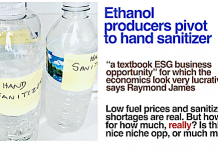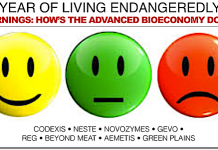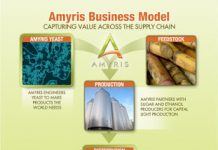by Debra Fiakas CFA
 Investors who took the time to read my last two posts on algae-based biofuel – “Algae Takes Flight” and “Emission Standards Driving Aviation Fuel Sourcing” – might have wondered why there was no mention of Solazyme, Inc. (SZYM: Nasdaq). California-based Solazyme has been pursuing algae-based oils for transportation since 2004, and managed to record its first product sales in 2011. However, that revenue was not from biofuel.
Investors who took the time to read my last two posts on algae-based biofuel – “Algae Takes Flight” and “Emission Standards Driving Aviation Fuel Sourcing” – might have wondered why there was no mention of Solazyme, Inc. (SZYM: Nasdaq). California-based Solazyme has been pursuing algae-based oils for transportation since 2004, and managed to record its first product sales in 2011. However, that revenue was not from biofuel.
On the long road to finding a scalable and efficient way to get renewable fuel from algae, Solazyme scientists found an interesting extract from the microalgae that settled in the filters of Solazyme’s culture tanks. The extract appeared to increase cell regeneration and protect skin from ultra-violet rays. Solazyme dubbed it “alguronic acid” and turned it into a line of anti-aging skincare products under the brand name Algenist.
They started distributing the skin care products in 2011 in Sephora stores in Europe, the Middle East and U.S. Those product sales in 2011, totaled $7.2 million and were principally from its “algae skin creams.”
This was not the first time Solazyme had found a market for by-products of its processes that yield both oils and proteins from microalgae. In 2010 the company launched a dietary supplement called Golden Chlorella, but recorded no revenue in that year. Golden Chlorella is an alternative to standard protein sources such as soy or egg. It is now available at Whole Foods and GNC stores.
While Golden Chlorella is not likely to show up on a plate next to a steak, it has attracted the attention of Roquette, the French food ingredients conglomerate. Solazyme entered into a joint venture with Roquette for the development and marketing of food products using algae proteins and oils. The partners apparently have high hopes for a second food ingredient, “whole algalin flour.” The flour was launched in 2012 at food trade shows under the brand name Almagine. Solazyme sales reps offered chocolate chips cookies made with the novel flour to prove how tasty it is.
Skin care products using Solazyme’s microalgae extracts are already generating respectable revenue. Solazyme’s oils and proteins are expected to show up in food products on store shelves as early as 2013. That may disappoint some investors who thought Solazyme would turn the transport fuel market on its ear with an algae-based biofuel.
A funny thing seems to have happened on the way to high volumes of algae oil to power in cars and trucks. Solazyme accumulated a vast knowledge base in microalgae and appears to have developed a new respect for algae’s full potential. The company has not given up on its objective to produce oils that can be substituted for petroleum in chemicals and fuels. However, a singular focus on one category would probably sell algae short. Like petroleum there is opportunity for algae oils in pharmaceutical applications. A bonus is that live algae present a third use in nutritional applications.
Just the same, investors might look at Solazyme and suggest that after nearly ten years in business with only nominal revenue and significant losses, the company is an abject failure. (The same investors might be content to wait twice that long for a pharmaceutical company to bring a drug or market, but I will let that go for now.) Particularly in this presidential election year when the incumbent president has been criticized for support of alternative energy, Solazyme might be a good whipping boy. The company received $22 million in December 2009 from the Department of Energy that was used to develop biofuel production capabilities in Solazyme’s Peoria facility.
Before coming down to hard on Solazyme, it is important to note that pharmaceutical and nutritional applications can be satisfied with low volume production capacity. Furthermore, products aimed at these market segments typically generate high margins. It makes sense to target these markets first to support subsequent development of high volume production capacity required for transport fuel production. I do not think Solazyme should be considered failure for pursuing what is just smart business.
To be fair, Solazyme has accumulated a deficit of $142.8 million. Despite $78.9 million in revenue earned from research projects over the last six and a half years, the company has had a fairly hefty bill to pay for research and development. Since the beginning of 2006, research and development spending has totaled $136.7 million. After its initial public offering in 2011, the company geared up its R&D activities, spending over half of the total R&D or $79.4 million in the last eighteen months.
So far Solazyme’s R&D efforts have earned it four patents and adequate technology for another 150 patent applications (some are duplicates in the U.S. and foreign jurisdictions). None of this intellectual property is represented on Solazyme’s balance sheet. Indeed, its tangible assets are near $239 million, composed most of $185.5 million in cash and marketable securities. The rest is principally property, plant and equipment and receivables. On per share basis net tangible assets (net of total liabilities) are approximately $3.40 per share or nearly a third of the current stock price. This suggests investors are valuing Solazyme’s intellectual property at around $7.10 per share.
On the surface that value might seem fair, or even a premium, if the investor has no confidence in Solazyme’s ability to launch a product into its primary target market for chemicals and fuels. In the next post, we will take a closer look at Solazyme’s sugar-to-oil process and try to figure out the probability it can yield the volumes needed to bring a return to Solazyme shareholders.
Debra Fiakas is the Managing Director of Crystal Equity Research, an alternative research resource on small capitalization companies in selected industries.
Neither the author of the Small Cap Strategist web log, Crystal Equity Research nor its affiliates have a beneficial interest in the companies mentioned herein.









